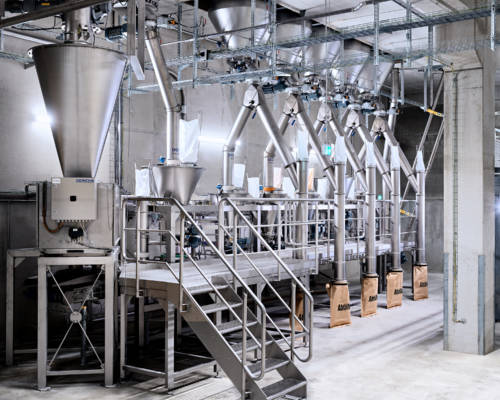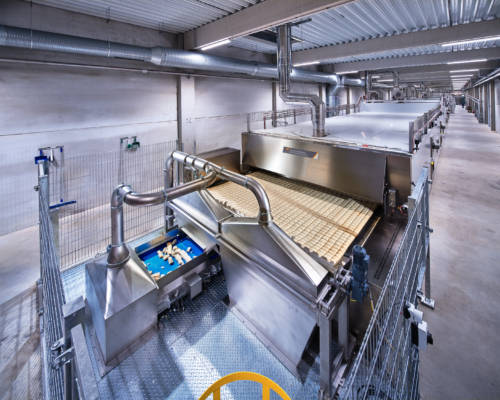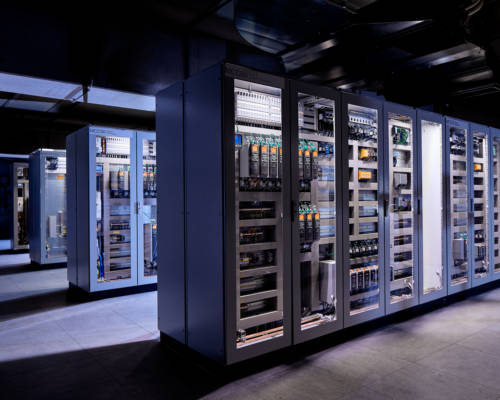Complete plant for breadcrumbs manufacturer
Realization of a fully automatic production line
The company BRATA is a manufacturer of breadcrumbs and breading for the food industry. The flours are also used to produce wet breadings with liquid components and fats. Thus, the company in Neuss offers industrial customers a wide range of dry and wet breadings for fish, meat and poultry as well as baking doughs. The family-owned company has been producing breadcrumbs since 1953, and the first fully automated production line was built in 1968. Others followed in 1992 and 2007, and the fourth line has now gone into operation at a new location. Since there are no further expansion possibilities at the current site at the Erprather Mühle in Neuss, the future of the third-generation family business lies in Nettetal. With the new location in Nettetal, a site of about 120,000 m² was found that offers the right size and an optimal infrastructural connection. The 120 meter long and 22 meter high building was already completed in October. Initially, 30 new jobs are to be created; after the final expansion, the number is expected to rise to 60 to 70.
Increasing demand and the investment in new technologies were the decisive points for the construction of a new production line. Concept development, project management and project control of the entire plant were realized by DERICHS GmbH Verfahrenstechnik from Übach-Palenberg.
The production of breadcrumbs does not simply involve the grinding of bread. The production includes many different process steps.
BRATA’s product range includes many different recipes for the production of breadcrumbs and therefore the process of raw material addition and dosing is the first complex and important process step. The basic ingredient for any breading is flour. In the raw material receiving department, the flour is delivered by trucks and from there it is conveyed by a pneumatic conveyor to one of the 6 flour silos.
In the raw material infeed, the main ingredients of each recipe (e.g. salt or paprika powder) are dosed fully automatically onto a conveyor belt and then conveyed to a kneader where they are mixed with the liquids and processed into a dough. Since a very large conveying capacity is required for most products and the products are sometimes difficult to discharge, the new DDMG twin-shaft feeders were used at this point. With these feeders, a feed rate range of 1:15 can be achieved. In this range, a total of up to 7 dry substances can be metered to within a few grams. Uniform and accurate metering is of great importance for the subsequent dough, as otherwise an uneven dough carpet will be produced after shaping.
Once all the dry ingredients and liquids have arrived in the kneader in the correct proportions, a continuous output of 8.5 t/h of finished dough is produced within a few minutes. This is the first time that a new type of kneading process has been used. The dough is then rolled out by a roller mill to form a dough carpet approximately 3 meters wide. The dough carpet is fermented in a fermentation channel for about 30 minutes and then baked in a recipe-controlled oven. During this process, the dough has covered a distance of approximately 100 m.
After the baking process, the bread carpet is broken by a knock-off roller and then torn into small bread pieces by two ZMZD pre-tears. The bread pieces are then ground even smaller by the cutting mills or shredders developed and manufactured by DERICHS. This produces grain sizes that can be directly processed into breadcrumbs. After grinding, the moist bread is dried in a dryer at over 100°C within 4 minutes and then conveyed to silos by various bucket elevators. There, the finished breadcrumbs, which are still unsorted according to grain size, are temporarily stored. The entire process up to this step takes about 1.5 h. The silos are intermediate storage facilities. The silos are intermediate storage facilities to increase process reliability. Should a downstream plant section ever fail, the upstream process does not have to be interrupted.
BRATA offers its customers products specially adapted to their needs. These differ not only in the composition of the raw materials, but also in the grain size and grain distribution. For this purpose, the breadcrumbs are sieved in two stages after the drying process. This produces ten different fractions, which can be mixed together individually according to customer requirements using belt weighers. To be able to guarantee that there is enough product of the different grain sizes, roller mills can be used to grind each grain size into the next smaller grain sizes so that the grain distribution can be intelligently controlled. To ensure that the grain size is not destroyed by conveying, the breadcrumbs are gently conveyed in this section of the process using pendulum bucket elevators. Grains that cannot be used for the finished product are ground to fine flour with a hammer mill and can later be baked back into the process so that almost no residue remains. After the correct particle size distributions have been mixed together, the product is ready for sale and is packaged in bags, big bags (LFBH) or conveyed directly into silo trucks according to customer requirements. The process is permanently monitored for metal contamination using rotating magnets and search coils.
The entire process is controlled and monitored from a central control room. The plant operates fully automatically. A control and visualization system developed by DERICHS is available for monitoring and operation. The visualization is clearly arranged and intuitively designed so that the plant operators can quickly find their way around the system. The entire plant is displayed in the visualization in a simplified form and the status of each installed component can be checked at any time. For the first time, the DERICHS modular system ported to the TIA system (Siemens) was used for such a large plant. Since the processes were simulated as far as possible in advance, the plant went into production on schedule after a comparatively short commissioning period.
The entire plant was assembled by DERICHS fitters within one year (November 19 to November 20) and commissioned to production readiness by the end of December 2020. Industrial production started in January, initially in a 2-shift system and then in a 3-shift system at a dough output of 8.5 t/h. Due to the high degree of automation, it is possible to run the plant with only two to three plant operators per shift. Intelligent grinding of unneeded grains allows production output to be increased to a maximum, leaving residual product at the end as very fine breadcrumbs which can be baked back in at the start of the process, thus resulting in hardly any losses in production. The fourth generation of this unique production plant thus represents the technically achievable maximum in flexibility, economy and reliability for the industrial production of high-quality breadcrumbs.






